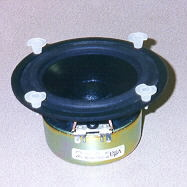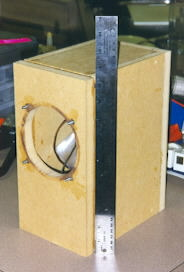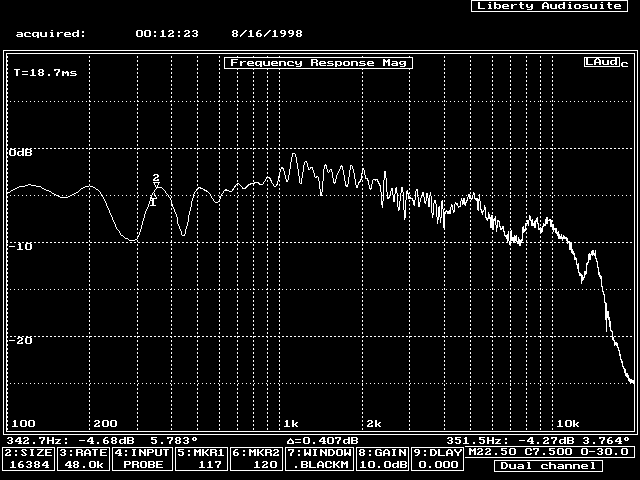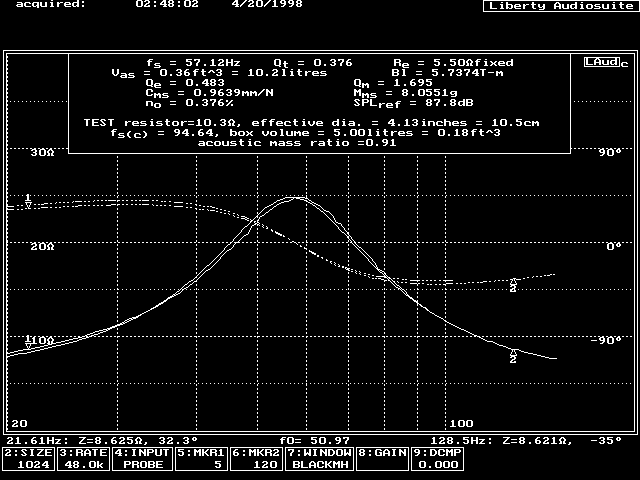The Mid-Ranges
These are the results of my March 1998 search.
Scan-Speak and Peerless are absent; no shielded drivers are available.
Dynaudio and Morel place the magnet inside of the driver basket.
That placement gives a tight magnet field that is close to,
but I don't believe as good as, bucking magnet shielding.
Eton makes a 4" shielded mid (at $98), but nothing larger.
Seas also makes some shielded co-axial drivers; a mid-range with the tweeter located
where the dustcap is normally found.
The mid's cone acts as a horn on the tweeter and modulates the tweeter's output
via the mid's cone motion.
The latter is a non-linear distortion.
Why then would anyone use a co-axial driver?
The big reason is the co-location of the mid-range and the tweeter.
The time delay between them is minimized, and almost invariant with changes in the
listening axis.
The modulation distortion is minimized by limiting the mid-bass and bass content
sent to the mid.
A 400 Hz cross-over to another mid-range or mid-bass unit has been commercial used
to accomplish this task.
Since the project goal is an MTM, not an WTMW (W for woofer), no co-axials were considered.
| Param | Vifa | Vifa | Vifa | Focal | Seas | Seas |
| Model | M13SG-09 | M17SG-09 | P17SJ-00 | 5N411LB | P14RC/TV
(H626) | P17RE/TV
(H690) |
| Price | 33.50 | 34.90 | 46.70 | 84.50 | 42.20 | 52.50 |
| Size | 5" | 6.5" | 6.5" | 5" | 5" | 6.5" |
| Mat. | Paper | Paper | Poly | Neoflex | Poly | Poly |
| Fs | 54 | 34 | 41 | 45 | 40 | 34 |
| Qts | 0.35 | 0.34 | 0.35 | 0.35 | 0.21 | 0.27 |
| Eff. | 88 | 89 | 87 | 87.5 | 89.5 | 88.5 |
| Vas | 12 | 53 | 33 | 14 | 18.9 | 30.5 |
| Xmax | 2 | 3 | 4 | 3.25 | 3 | 3 |
| Power | 35 | 50 | 70 | 60 | 60 | 80 |
These prices were "current" of 03/31/98 from Madisound.
Xmax ratings are peak one way.
The Vifa D27SG-05 does not have "tinsel leads"
or a similar technology.
I interpret this to mean a crossover frequency below 3 kHz is not likely to lead
to long term tweeter reliability.
A crossover frequency above 3kHz limits the mid-range selection to 5" or smaller drivers.
This is not a cost-is-no-object design, which yields the Vifa M13SG-09 and Seas P14RC/TV
as the two best candidates.
The P14RC/TV manufacturer response curves shows some response anomylies in the 1-2 kHz region
where the human ear is most sensitive.
My conclusion: get the Vifa M13SG-09.
The measurements of the Vifa M13SG-09 were good enough that no other units have
been examined.
Vifa M13SG-09

|
The raw driver.
Several points are worth noticing.
The translucent plastic tabs placed in the mounting screw holes keep the surround from getting
crushed during shipment. Very Nice!
The magnets (one is a bucking magnet, placed such as to cancel out the magnetic field of
the other) are covered with a steel cup.
Although the cone is paper, it appears quite shiny.
This is from a plastic coating, which gives the mid a "wet" look.
The dustcap is well damped, but is not soft like the Vifa poly mid.
|

|
The first frequency response test was performed on a small test box that was also used
for calculating driver Vas.
The measurement distance was 46 cm and the time window is about 18.6 milliseconds.
The small dimensions of the test cabinet make it difficult to evaluate which of the response
anomilies can be traced to the driver.
The manufacturer's data sheet shows a broad 1-2 dB dip at 2 kHz and
a narrow 3-5 dB dip at 6.5 kHz.
|

The LAud results of mid-range B tested for its Thiele-Small parameters.

The table below summarizes the Thiele-Small testing I have done so far on the dozen mid-ranges that
I ordered. (Yep, a dozen!)
The results are before any break-in of the suspensions.
The test signal level was -30 dB.
| | Spec | A | B | C | D | E | F
| G | H | I | J | K | I
|
| Re | 5.6 | 5.6 | 5.5 | 5.6 | 5.45 | 5.5 | 5.6
| 5.5 | 5.5 | 5.6 | 5.6 | 5.6 | 5.6
|
| fs | 54 | 54.45 | 57.71 | 57.25 | 55.31 | 56.63 | 57.96
| 56.19 | 54.22 | 52.87 | 53.82 | 56.95 | 58.26
|
| Qts | 0.35 | 0.370 | 0.383 | 0.379 | 0.356 | 0.351 | 0.349
| 0.371 | 0.351 | 0.368 | 0.352 | 0.352 | 0.373
|
| Vas | 12 | 11.5 | 10.2 | N/A | N/A | N/A | N/A
| N/A | N/A | N/A | N/A | N/A | N/A
|
Copyright © 1998 John Lipp



